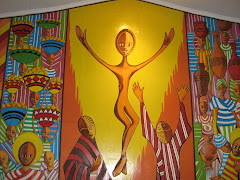
of the transfigured body
of the Lord
in our daily events
and interactions?
Daniel 7:9-10,13-14
2 Peter 1:16-19
Mark 9:2-10
There is a mysterious story in 2 Kings that can help us understand what is going on in the transfiguration. Israel was at war with Aram, and Elisha the man of God was using his prophetic powers to reveal the strategic plans of the Aramean army to the Israelites. At first the King of Aram thought that one of his officers was playing the spy but when he learnt the truth he dispatched troops to go and capture Elisha who was residing in Dothan. The Aramean troops moved in under cover of darkness and surrounded the city. In the morning Elisha’s servant was the first to discover that they were trapped in and feared for his master’s safety. He ran to Elisha and said, “Oh, my lord, what shall we do?” The prophet answered, “Don't be afraid. Those who are with us are more than those who are with them.” But who would believe that, when the surrounding mountainside was covered with advancing enemy troops? So Elisha prayed, “O Lord, open his eyes so he may see.” Then the Lord opened the servant's eyes, and he looked and saw the hills full of horses and chariots of fire all around Elisha (2 Kings 6:8-23). This vision was all that Elisha’s disciple needed to reassure him. At the end of the day, not only was the prophet of God safe but the invading army was totally humiliated.
The Transfiguration of Jesus happened at a stage in his public ministry when he was pretty much in the same situation as Elisha. His foes were closing in on him and his disciples led by Peter were feeling very much like the servant of Elisha, afraid and anxious for their master’s safety. Just before the Transfiguration Jesus had asked his disciples whom the people and they themselves thought he was. Peter gave the correct answer the he was Christ the son of the living God. Jesus congratulated him and then proceeded to forewarn them and prepare them for his unavoidable suffering, death and resurrection. But Peter was not ready for this. He protested visibly; he took Jesus aside and began to rebuke him, saying, “Never, Lord! This shall never happen to you!” Jesus sharply corrected him, telling him that he was seeing things from a purely human point of view (Matthew 16:13-23). He needed, like Elisha’s servant, a vision from God’s point of view, to see that in spite of the death sentence hanging over the head of Jesus, God was still with him, God was still in control of events, God would see to it that in the end he triumphed over his foes as Elisha did. What Peter and his fellow disciples needed was for God to open their eyes and them give them a glimpse of God’s abiding presence with their master Jesus. The transfiguration was that experience.
The Transfiguration experience was, therefore, God’s way of delivering the disciples from a crisis of faith. The cause of their crisis of faith was the way in which they saw people and things around them. God helped them out of it by enlightening their vision so that, at least for a moment, they could see from God’s own perspective. Seen from below, in ordinary human light, people and things around us may look drab, commonplace and sometimes repulsive. But seen from above, in the light of divinity, the same people and things take on a more honourable, resplendent and lovable appearance. This glimpse into the true nature and divine aspect of persons and things can be called a transfiguration experience. It is the kind of experience which makes us say with Jacob, “Surely the Lord is in this place, [person, or situation] and I did not know it!” (Genesis 28:16).
Where can one get this Transfiguration experience? Everywhere. Our Sunday worship is a good starting point. Outside the church, right from the church parking lot, we tend to see one another as competitors. On the road we see other road users as obstacles impeding our speedy arrival to our destinations. In the work place we see others as rivals vying with us for the ladder of success. But at Mass we have the singular experience of looking one another in the eye and calling them “brothers and sisters.” This is indeed a Transfiguration. The challenge for us is to live in the light of this awareness until we come together again next Sunday to renew our faith vision.
!!!!!!!!!!!!!!!!!!!!!!!!!!!!!!!!!!!!!!!!
vmalpan@gmail.com

